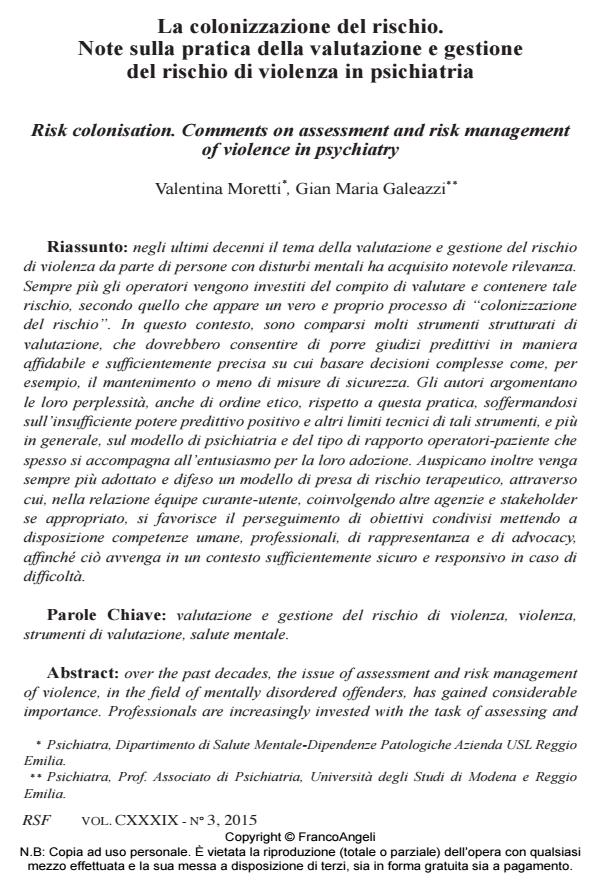La colonizzazione del rischio. Note sulla pratica della valutazione e gestione del rischio di violenza in psichiatria
Titolo Rivista RIVISTA SPERIMENTALE DI FRENIATRIA
Autori/Curatori Valentina Moretti, Gian Maria Galeazzi
Anno di pubblicazione 2015 Fascicolo 2015/3
Lingua Italiano Numero pagine 18 P. 71-88 Dimensione file 2211 KB
DOI 10.3280/RSF2015-003005
Il DOI è il codice a barre della proprietà intellettuale: per saperne di più
clicca qui
Qui sotto puoi vedere in anteprima la prima pagina di questo articolo.
Se questo articolo ti interessa, lo puoi acquistare (e scaricare in formato pdf) seguendo le facili indicazioni per acquistare il download credit. Acquista Download Credits per scaricare questo Articolo in formato PDF

FrancoAngeli è membro della Publishers International Linking Association, Inc (PILA)associazione indipendente e non profit per facilitare (attraverso i servizi tecnologici implementati da CrossRef.org) l’accesso degli studiosi ai contenuti digitali nelle pubblicazioni professionali e scientifiche
Negli ultimi decenni il tema della valutazione e gestione del rischio di violenza da parte di persone con disturbi mentali ha acquisito notevole rilevanza. Sempre più gli operatori vengono investiti del compito di valutare e contenere tale rischio, secondo quello che appare un vero e proprio processo di "colonizzazione del rischio". In questo contesto, sono comparsi molti strumenti strutturati di valutazione, che dovrebbero consentire di porre giudizi predittivi in maniera affidabile e sufficientemente precisa su cui basare decisioni complesse come, per esempio, il mantenimento o meno di misure di sicurezza. Gli autori argomentano le loro perplessità, anche di ordine etico, rispetto a questa pratica, soffermandosi sull’insufficiente potere predittivo positivo e altri limiti tecnici di tali strumenti, e più in generale, sul modello di psichiatria e del tipo di rapporto operatori-paziente che spesso si accompagna all’entusiasmo per la loro adozione. Auspicano inoltre venga sempre più adottato e difeso un modello di presa di rischio terapeutico, attraverso cui, nella relazione équipe curante-utente, coinvolgendo altre agenzie e stakeholder se appropriato, si favorisce il perseguimento di obiettivi condivisi mettendo a disposizione competenze umane, professionali, di rappresentanza e di advocacy, affinché ciò avvenga in un contesto sufficientemente sicuro e responsivo in caso di difficoltà.
Parole chiave:Valutazione e gestione del rischio di violenza, violenza, strumenti di valutazione, salute mentale
Valentina Moretti, Gian Maria Galeazzi, La colonizzazione del rischio. Note sulla pratica della valutazione e gestione del rischio di violenza in psichiatria in "RIVISTA SPERIMENTALE DI FRENIATRIA" 3/2015, pp 71-88, DOI: 10.3280/RSF2015-003005